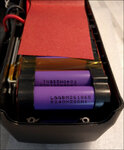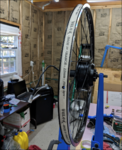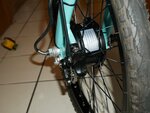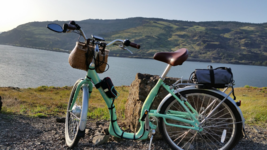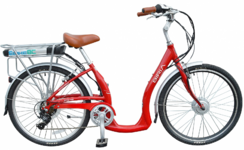stanmiller
Active Member
After a few years of lurking around here and endless-sphere, I finally took the plunge and converted my Electra Townie to an e-bike. I’m now over 530 634 1386 2000 2530 miles in and couldn’t be happier.

I had ridden this Townie and prior Trek Pure thousands of miles and along the way tuned the drive train to an 8-speed 11-32t cassette (Shimano), 38t chain ring (Absolute Black), and X7 derailleur (SRAM). This configuration has been great for flats and hills alike. And since the e-conversion the bike continues to be well balanced, now flattens hills, and cruises near 30 mph/48 kph at the highest PAS.
I settled on a 500W Bafang rear hub kit from Bluenergy. It had everything I needed less the optional battery. I chose to source the battery elsewhere to allow for extra vetting.
Bluenergy has an online store hosted at Aliexpress, but you can also find their kits through resellers on Amazon.
Bluenergy at AliExpress.com
The trickiest part of the conversion was the disc brake. My Townie doesn’t have a disc brake mount. To workaround I installed an adapter from A2Z. So far it’s been solid.
To power things, I picked up a 48v/13Ah battery from vendor Joyisi on Amazon. The battery has LG cells and has behaved well through a half-a-dozen charge cycles. I’ve taken it over 40 miles on a charge with bars remaining.
Amazon: Joyisi 48v 13Ah battery
Total cost for the conversion was just over $800 including the BB5 disc brake kit.
If you’re looking to go electric on an e-curious budget, this is a kit I would recommend.

I had ridden this Townie and prior Trek Pure thousands of miles and along the way tuned the drive train to an 8-speed 11-32t cassette (Shimano), 38t chain ring (Absolute Black), and X7 derailleur (SRAM). This configuration has been great for flats and hills alike. And since the e-conversion the bike continues to be well balanced, now flattens hills, and cruises near 30 mph/48 kph at the highest PAS.
I settled on a 500W Bafang rear hub kit from Bluenergy. It had everything I needed less the optional battery. I chose to source the battery elsewhere to allow for extra vetting.
Bluenergy has an online store hosted at Aliexpress, but you can also find their kits through resellers on Amazon.
Bluenergy at AliExpress.com
The trickiest part of the conversion was the disc brake. My Townie doesn’t have a disc brake mount. To workaround I installed an adapter from A2Z. So far it’s been solid.
To power things, I picked up a 48v/13Ah battery from vendor Joyisi on Amazon. The battery has LG cells and has behaved well through a half-a-dozen charge cycles. I’ve taken it over 40 miles on a charge with bars remaining.
Amazon: Joyisi 48v 13Ah battery
Total cost for the conversion was just over $800 including the BB5 disc brake kit.
If you’re looking to go electric on an e-curious budget, this is a kit I would recommend.
Attachments
Last edited:


